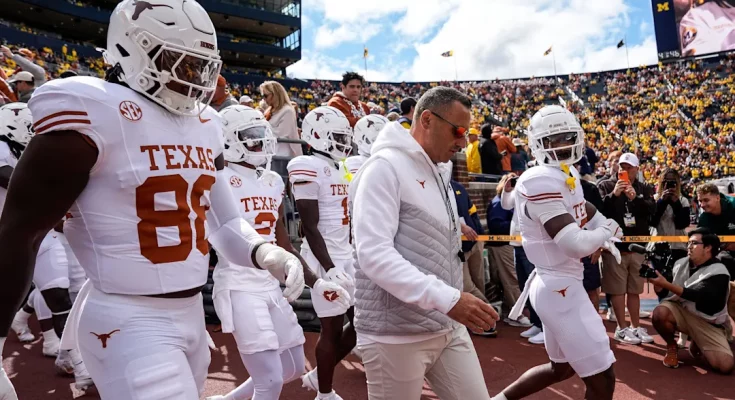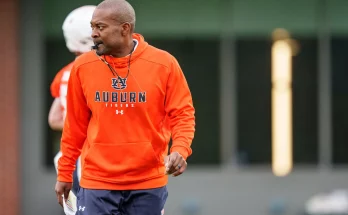To win the national championship, the Texas Longhorns must answer these three questions.
Texas enters the 2025 season as the team to beat. They are the preseason favorites to win the SEC and the national title, with odds around +550 for the championship and +280 for the conference crown . After reaching the CFP semifinal two years in a row under Steve Sarkisian, the Longhorns are seen as one step away. But talent alone won’t be enough—three critical questions remain before they can truly lift the ring.
First, can Arch Manning live up to expectations and stay healthy while leading this offense? Manning takes over as the full‑time starter in 2025 after backing up Quinn Ewers for two years. He is already a Heisman contender, praised by former coach Mack Brown for his humility and leadership—much like Vince Young in his early years . Experts like Sports Illustrated’s Harrison Reno express caution: Manning’s mobility gives Texas an added dimension, but his inexperience introduces risk—turnovers and growing pains could hold them back in tight games . Even bracket projections that seed Texas number one assume Manning will be key, but the true test comes in big moments, especially early against Ohio State and later in the SEC at Georgia .
Second, can Texas replace a huge amount of returning production—especially on offense—without skipping a beat? After a 13–3 season that produced a program‑record 12 NFL Draft picks, the Longhorns return just around 40 percent of offensive production, while defense returns about 62 percent . They lost multiple offensive linemen, receivers, and their kicker. Sarkisian has reloaded through the transfer portal and top recruiting classes, bringing impact players like Derrek Cooper, Tyler Atkinson, and JJ Johnson on both sides of the ball . But replacing cohesion is harder than replacing talent; if chemistry stalls or mistakes pile up in early games, production losses could cost them critical wins.
Third, can the defense handle elite opponents and carry the team in close games? Texas boasts one of the deepest linebacker and edge groups in the country. Experts say the front seven is athletic, experienced, and perhaps the best they’ve had in decades . Defensive leaders like Michael Taaffe unite the unit; his bond with Manning helps set the tone across the roster . Still, skeptics worry that young or new starters in the secondary and front line replacements may face durability tests when matched with SEC run games and top receivers. Depth matters, but only if the second group performs under pressure.
Answering these questions isn’t theoretical it starts from the first play of the season. Texas opens on August 30 at Ohio State, the defending national champs, in Columbus . Expectations clash with reality there: sportsbooks have Texas as favorites to win the title, yet odds boards give Ohio State (+500) and Texas (+450 or +550) nearly even positioning . That season opener could shape everything: a win would validate Manning, rally momentum, and quiet critics. A loss raises doubts about depth, execution, and mental readiness.
When conference play begins, Texas charts a gauntlet: Georgia on the road, Florida, Alabama, and others loom large. Experts point to March 1992–present stats: only 30 percent of preseason SEC favorites have ended up champions . Texas fans hope Sarkisian turns history around. They believe the new SEC landscape with Texas now in Year 2 creates opportunity. As Sark himself stressed at SEC Media Days, balancing in-state recruiting with national talent, emphasizing development over shortcuts, and building culture remain core to success .
Arch Manning’s chemistry with Michael Taaffe highlights leadership beyond the X’s and O’s. Their bond began during recruitment and continues in the locker room, helping unify a team chasing history . That internal culture could keep the team steady through adversity, even if mistakes slide in from the learning process.
Yet analysts remain split. Thomas Casale calls Texas one of the most talented rosters in the country but predicts a 9.5‑win regular season, warning against laying heavy money on over bets, especially with early-season road tests . PFF and other preview outlets still rate Texas among the very top teams entering 2025, but emphasize questions around production turnover, youth in key positions, and inexperienced stars making plays in tight moments l.
Winning the national championship means passing three big tests: quarterback execution, offensive continuity, and defensive reliability. If Manning plays near‑perfect ball, if the offense replaces old stars without missing a beat, and if the defense feeds off its young talent at all levels, Texas can do more than reach the CFP they can finish it. But if one of those pieces falters, skepticism will grow.
Still, long-term momentum and coaching give Texas a chance. Sarkisian enters his fifth year with established systems, a 25‑5 record over the last two seasons, and clear expectations that he must deliver the title in 2025 or 2026—or risk falling short of Texas legend status . With top odds to win the national championship, fans believe the time is now
Sports Illustrated’s Ari Wasserman projects Texas as the No. 1 seed in the CFP, beating Oregon, rematching Ohio State in the semifinals, and winning the title over Clemson in the finalpartly because that path matches Texas’s depth, experience, and defensive identity . That scenario requires each “what‑if” question to become a real “why yes” answer on the field.
It’s a high‑risk, high‑reward situation. If health holds, internal development clicks, and leadership steadies early storms, Texas could break its long drought. If pressure breaks them, or an early slip causes community doubt, then expectations will turn to what‑if territory. The players and coaches know that. They’ve heard the chatter: “championship or bust.”
In the end, the conversation returns to three simple but vital questions: Can Arch Manning stay steady and efficient? Can the offense overcome the loss of top production with cohesion? Can the defense especially in the secondary and front seven handle pressure and anchor a title‑run?
Those are the questions that will define Texas’s season. And how they respond over the next five months will decide whether Longhorns fans finally get to celebrate a national title in Austin once again.



